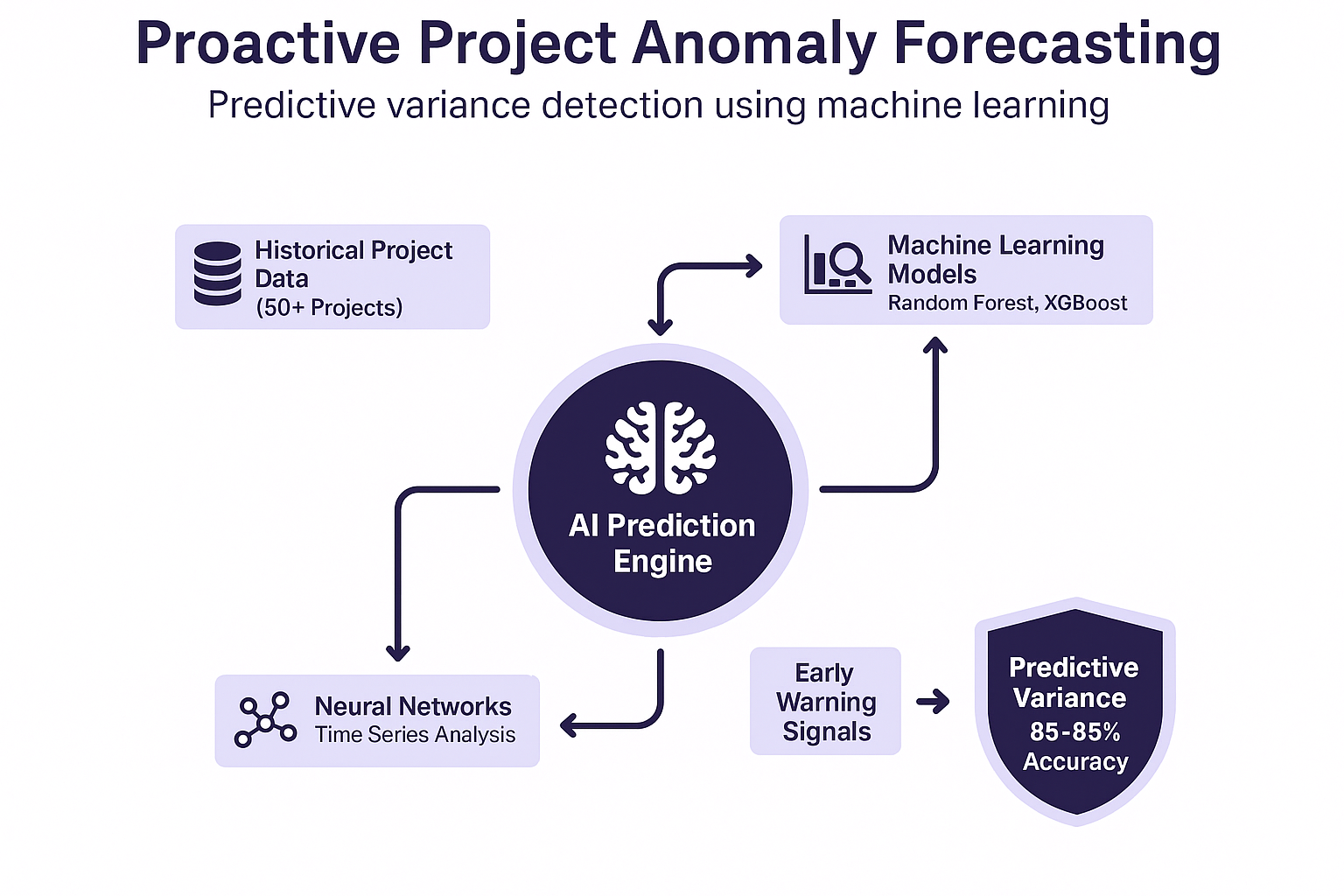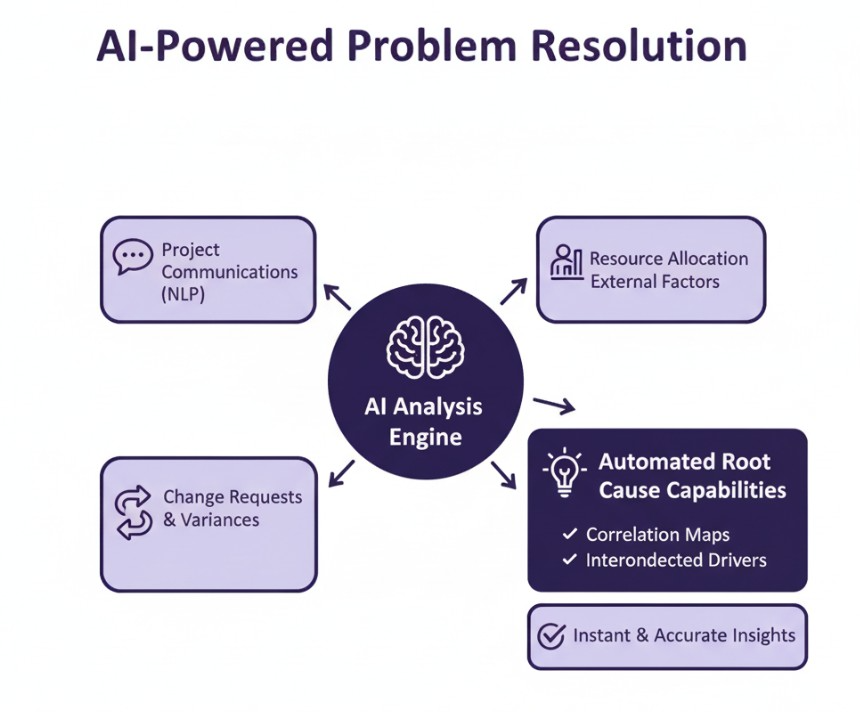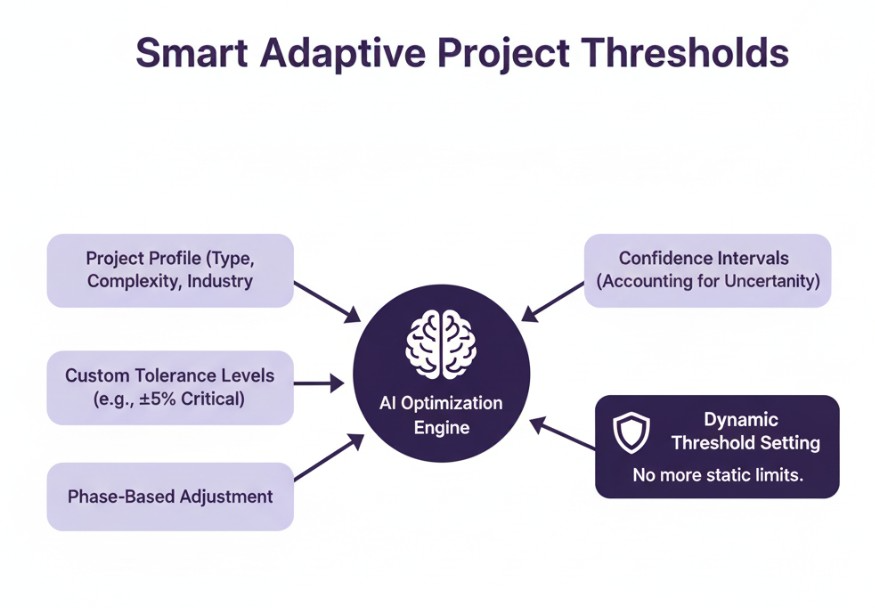Studies show that over half of projects exceed budgets and nearly 30% miss deadlines, even with experienced teams in charge. These gaps drain resources and erode stakeholder trust faster than most managers realize.
Understanding how AI can improve project variance analysis gives leaders a powerful edge, turning unpredictable overruns into risks that can be spotted and contained early.
In this article, we will:
- Improve project monitoring with 8 AI-powered variance methods
- Adapt AI variance analysis to fit your industry demands
- Apply AI variance tools differently for agile and waterfall projects
AI variance analysis transformation: 8 proven methods to revolutionize project monitoring
Traditional project variance analysis leaves teams reactive rather than proactive, struggling with manual data collection and delayed insights.
Artificial intelligence transforms this landscape by introducing automated intelligence that predicts, prevents, and resolves variances before they derail project success.
Here are eight game-changing methods that demonstrate how AI can transform your variance analysis:
1. Automated real-time data collection and processing
AI-powered integration tools create a seamless data pipeline that continuously monitors your project ecosystem. Gone are the days of spending workdays gathering scattered project data.
Key implementation strategies:
- Deploy APIs connecting ERP systems, project management platforms, and financial software
- Implement machine learning algorithms to standardize data formats automatically
- Create unified dashboards updating every 15-30 minutes
- Eliminate manual data entry through intelligent mapping

Teams typically reduce data collection time from 8-16 hours per week to completely automated real-time updates. A construction company implementing this approach found 25% faster issue resolution as project managers focused on strategic decisions instead of data gathering.
2. Predictive variance detection using machine learning
AI enables you to predict variances 2-4 weeks in advance instead of discovering problems after they occur. Machine learning models analyze historical patterns to identify early warning signals.
Core prediction techniques:
- Train Random Forest and XGBoost algorithms on 50+ historical projects
- Utilize Neural Networks for complex cost overrun patterns
- Implement time series analysis for seasonal variance patterns
- Deploy ensemble methods combining multiple algorithms

Organizations implementing predictive detection achieve 85-95% accuracy in identifying critical variances before they impact deliverables. A technology company prevented $2.3 million in potential overruns by addressing predicted variances early.
3. Intelligent root cause analysis
AI transforms root cause analysis by automatically connecting the dots across multiple project dimensions. Traditional analysis requiring hours of manual investigation becomes instant and accurate.
Automated analysis capabilities:
- Process project communications using Natural Language Processing
- Analyze change requests and variance correlation patterns
- Examine resource allocation data and external factors
- Generate correlation maps showing interconnected drivers

This approach reduces root cause analysis from 4-6 hours to 15-30 minutes while maintaining 90% accuracy. Teams quickly understand whether cost variances stem from material prices, resource inefficiencies, or scope modifications.
4. Dynamic variance threshold setting
AI creates adaptive thresholds that automatically adjust based on project characteristics and historical data. Static thresholds often generate false alarms or miss critical issues.
Smart threshold optimization:
- Analyze project type, complexity, and industry benchmarks
- Set custom tolerance levels (±5% for critical path, ±10% for non-critical)
- Adjust thresholds based on project phases
- Implement confidence intervals accounting for uncertainty

This dynamic approach eliminates 60-80% of false positive alerts while ensuring no critical variances are missed. Teams experience less alert fatigue and trust that notifications require genuine attention.
5. Automated corrective action recommendations
When variances occur, AI recommends specific solutions through decision trees and optimization algorithms. Teams receive actionable guidance instead of just problem identification.
Intelligent recommendation features:
- Evaluate available resources and project constraints
- Generate prioritized action plans for resource reallocation
- Suggest scope modifications with minimal impact
- Provide a cost-benefit analysis for each intervention

Teams using automated recommendations reduce variance resolution time by 40-60% because they receive pre-validated action plans. The AI system learns from past interventions to improve future recommendations.
6. Multi-dimensional variance correlation analysis
AI uncovers hidden relationships between different variance types, helping teams understand ripple effects. Individual variances rarely occur in isolation.
Advanced correlation capabilities:
- Identify relationships between cost, schedule, scope, and quality variances
- Predict cascading effects when variances trigger others
- Map cross-functional dependencies and impacts
- Generate early warnings for secondary variances

This comprehensive analysis helps prevent 70-85% of secondary variances through proactive intervention. Teams gain holistic views of how changes affect entire project ecosystems.
7. Continuous learning and model improvement
AI systems become smarter through reinforcement learning that continuously refines prediction accuracy based on actual outcomes. The technology evolves with your organization.
Self-improving capabilities:
- Automatically retrain models monthly using new data
- Adjust algorithms based on accuracy feedback
- Incorporate lessons from variance resolution outcomes
- Adapt to changing project environments
Organizations typically see 5-10% annual improvement in prediction accuracy as AI systems mature. This continuous enhancement ensures increasing value over time.
8. Natural language variance reporting
Complex variance data becomes accessible through AI-generated narratives that translate technical information into clear insights. All stakeholders understand project status regardless of their technical background.
Intelligent reporting features:
- Generate executive summaries for different stakeholder levels
- Create human-readable explanations of variance causes
- Produce automated status updates in natural language
- Customize communication styles based on the audience
This capability reduces report preparation from 4-8 hours to 5-minute generation while ensuring consistent communication. Instead of raw percentages, AI generates: "The project experiences 12% cost variance from increased material prices, with corrective actions reducing this to 8% by month-end."
Pro tip: Start implementation with real-time data collection, then gradually add predictive capabilities as your data quality improves.
These eight AI-powered improvements transform project variance analysis from a time-consuming reactive process into a strategic advantage that keeps projects on track and stakeholders informed.
Industry-specific variance analysis: Tailored AI solutions for maximum impact
Every industry faces unique project challenges that require specialized variance analysis approaches. While AI fundamentals remain consistent, the application and focus areas vary dramatically across sectors, making industry-specific implementation crucial for maximum effectiveness.

Construction project variance patterns
Construction projects are notorious for schedule delays and budget overruns caused by unpredictable variables like weather, labor shortages, or material supply chain issues; a construction project management plan template helps standardize controls across phases.
- AI method: Predictive models forecast delivery risks for materials and labor availability.
- Implementation: Integrating AI with construction management software (Primavera, Procore) to track procurement and workforce schedules.
- Result: Early warnings about delays help avoid cascading cost overruns.
Example: A contractor used AI variance alerts to anticipate a steel delivery delay and secured an alternate supplier two weeks ahead, saving the project from a 6% budget spike.
Software development variance tracking
In software projects, variance usually comes from scope creep, shifting priorities, or resource bottlenecks. Tracking these in real-time is critical for agile teams.
- AI method: NLP tools analyze sprint retrospectives and ticket updates to detect recurring blockers.
- Implementation: Machine learning predicts likely sprint slippages by reviewing historical velocity and backlog churn.
- Result: AI predicts schedule deviations 2–3 sprints ahead, giving teams a chance to realign priorities.
Pro tip: Pair AI variance dashboards with burndown charts to make predictive insights easily digestible for non-technical stakeholders.
Manufacturing project considerations
Manufacturing projects often face variance risks tied to quality control and production efficiency. Even small deviations can snowball into costly recalls or downtime.
- AI method: Real-time sensor data and IoT feeds connected to predictive variance models.
- Implementation: AI correlates machine performance data with production schedules to identify early signs of defects or downtime.
- Result: Prevents unplanned downtime, while reducing scrap rates and improving cost predictability.
Example: A factory applied AI-based variance analysis to machine maintenance logs, reducing variance-driven downtime by 18% in a single quarter.
Healthcare project complexities
Healthcare projects, such as clinical trials or hospital expansions, carry extremely high stakes and regulatory oversight. Variance here often revolves around patient enrollment delays, compliance issues, or cost overruns tied to regulatory changes.
- AI method: Forecasting algorithms predict trial enrollment variances based on demographic and geographic data.
- Implementation: AI monitors compliance data and external policy updates to flag risks early.
- Result: Project managers reduce the risk of trial delays or budget expansions by acting on AI-driven variance alerts.
Pro tip: In regulated industries like healthcare, AI-powered variance analysis should always include transparent explainability features for audit and compliance teams.
Across industries, AI transforms variance analysis from reactive reporting to proactive insight, enabling smarter decisions and stronger project outcomes.
Agile vs. Waterfall: Tailoring AI variance to your delivery model
AI doesn’t treat every project methodology the same. Variance signals, prediction windows, and corrective actions differ depending on whether you run agile or waterfall. Understanding these differences helps project managers apply AI in the right way and avoid false expectations.
AI essentially shrinks variance detection cycles in agile by watching sprint-level signals, while in waterfall, it helps forecast phase-level risks months in advance.
Pro tip: Don’t force the same AI model across both methods; train variance models on methodology-specific data for more accurate and actionable results.
Use AI to protect budgets, timelines, and stakeholder trust
Project variance doesn’t have to be a guessing game. By applying AI to data collection, predictive detection, root cause analysis, and tailored industry workflows, teams gain the power to spot risks before they escalate.
Smarter variance monitoring in financial project management software means fewer overruns, faster resolutions, and greater confidence in every decision. Now is the time to embed AI into your project playbook and turn variance analysis into a driver of trust and success.


%20(1).jpg)
_light%201.png)





